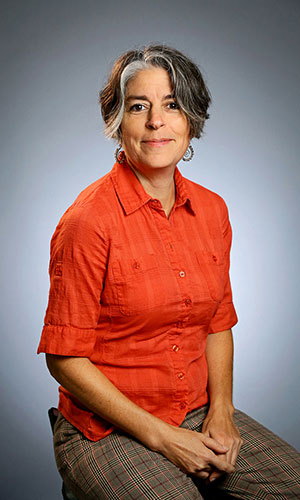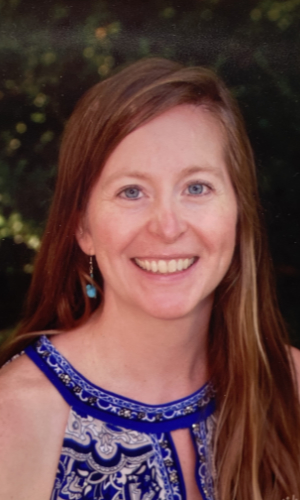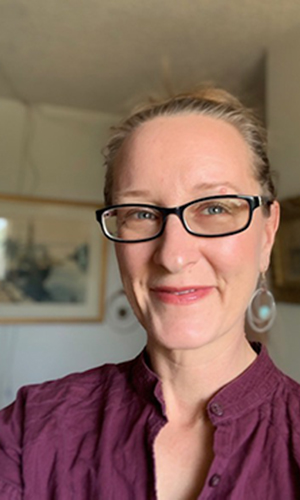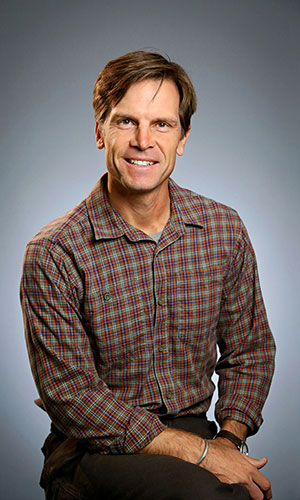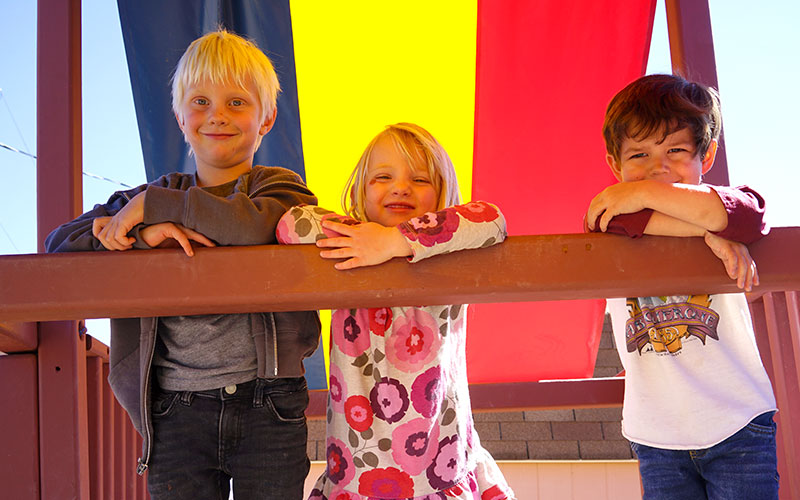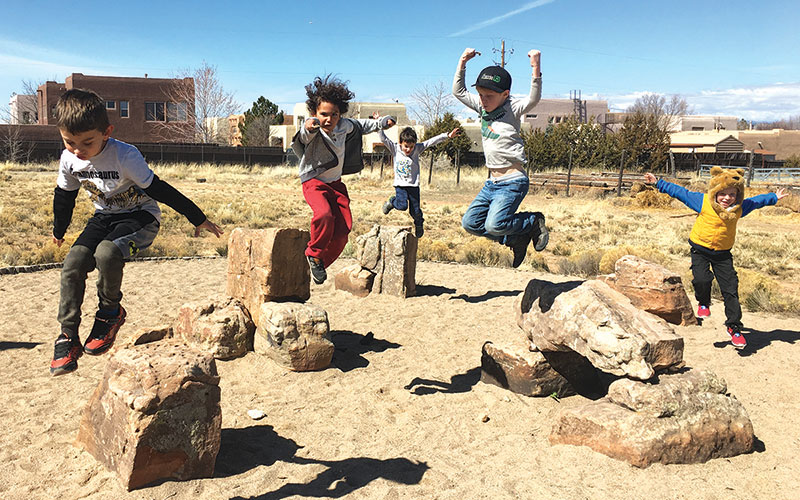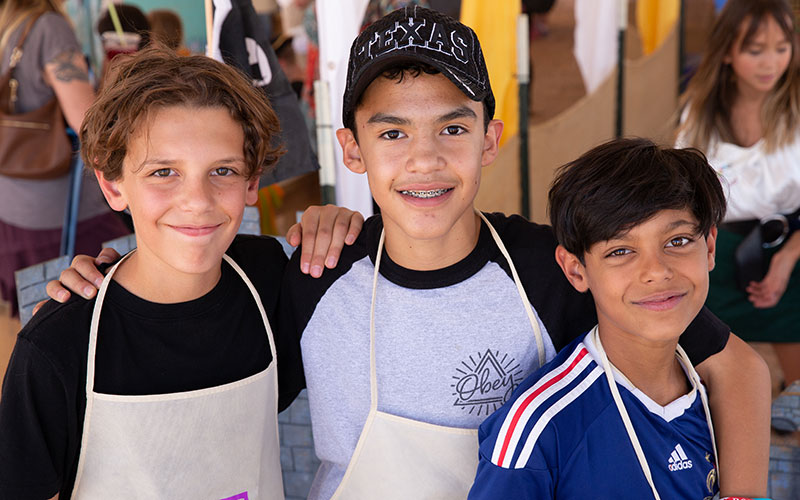
PRESCHOOL & PRE-KINDERGARTEN PROGRAM
At Santa Fe School for the Arts & Sciences, we believe that education involves the whole child– heart, hands, and head. We strive to help children become balanced, integrated and harmonious human beings. In our Preschool and Pre-k Unicorn class we believe in supporting a passion for learning, wondering, and self expression, but also in the development of good character, a healthy sense of self, and positive qualities such as resilience, respect for self and others, generosity, compassion, and caring. Social and emotional development is an important foundation for all that we do.
In keeping with our whole-child approach to learning, we believe that the best environment in which children thrive and grow is in an environment that is safe and supportive, stimulating and challenging, fun and playful, and open and expansive.
We bring together a teaching team that embodies these qualities, to create an optimal setting in which children can live and learn. We welcome parents and extended families as an integral part of this circle of working, playing, dancing, and laughing, where we teach and learn together.
REGGIO EMILIA
We approach education in the Unicorn classroom through a reflective practice inspired by the Reggio Emilia Approach, honoring the child as competent, capable and resilient. “The 100 Languages of Children” honors how each child learns, discovers, and makes meaning of the world around them, through the expression and exploration of different mediums, or “languages”, like clay, paints, wire, movement, song, storytelling, writing, blocks… believing that real intelligence arises when children are given opportunities to engage not only their intellects, but also their hands and hearts, learning through cooperative experiences in community with other children and adults.
In the practice of the Reggio Approach, the curriculum emerges from teacher observations, notes and photos taken of children’s investigations. Reflection meetings happen weekly to see what students are exploring, and weekly schedules are made, which outline activities to deepen each student’s investigations and learning. The weekly activities may have a “provocation”, or a catalyst for exploration; it may be materials set out by teachers in response to student interests, the construction of a new center in the classroom environment, or new materials may be made available for children to explore.
Documentation panels are made of student’s learning and discoveries; these panels are often comprised of photographs, artwork, teacher observations, and quotes from children. They are read to students and displayed for them to view, which deepens the student’s learning, as well as the teachers’ understanding of the students’ interest. Panels are hung in the hallway and in the classroom for families to see.

LICENSING AND ACCREDITATION
We are licensed by CYFD (Children Youth and Family Department) as a Five Star Preschool/Pre-K Program in the state of New Mexico. We are also nationally accredited by NAEYC (National Association for the Education of Young Children) which is the highest designation for a quality preschool program, as determined by the NAEYC Accreditation Standards.
We support and nurture opportunities for each child to grow within the main areas of development while working with the New Mexico Early Learning Guidelines.
Providing a rich environment that meets the state and national standards creates the foundation for a life of learning, which prepares children for kindergarten and beyond.

LANGUAGE ARTS
Our rich Language Arts program is embedded in our daily curriculum, such as learning phonics through the “Letter of the Week” program, and through song, reading signs, labels in English and Spanish, names around the classroom, learning rhymes and songs, telling and making up stories, listening and reflecting on stories read during “Story Time,” expressing oneself and learning to write the letters of the alphabet and the conventions of writing, through our Handwriting Without Tears Program. Our Language Arts Program nurtures children to develop skills through which they use as one of the “Languages” in the “Hundred Languages of Children,” to express themselves as they learn and make meaning of the world in which they live. This child centered approach to supporting emergent readers and writers is best practice, to set the foundation for conventional reading and writing in elementary school, as well as creative thinking through the language of literacy.
We value all languages spoken by students and foster the development of a child’s home language, as well as the development of the English language. Spanish and ASL are integrated in our daily curriculum and our daily routines.
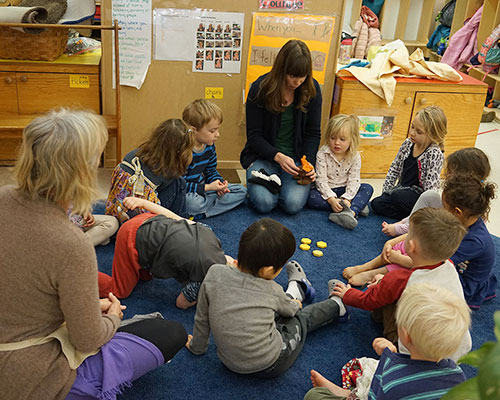
NUMERACY
The Numeracy program is integrated throughout the classroom and daily schedule. Children have opportunities to use numbers and counting as means for solving and determining quantity, such as counting books to read on nap mats, toys to pick up outside, or reading the number cards for snack time to serve themselves the correct number of items, or having the “Number Job.” They learn to recognize shapes when having the “Shape Job”, where they have fun learning how to describe, compare and create shapes or find them around the classroom. We also teach how to use shapes when drawing. They explore measurement like length, height, weight and time through the daily schedule, and in their play with the materials around the classroom, as well as learning to sort, classify and group materials by characteristics and attributes through their interaction, play and cleaning up the changing materials in the classroom. Providing multiple opportunities for children to touch, see, create and explore materials and early concepts in algebra and geometry provide the building blocks for success in math into kindergarten and up.
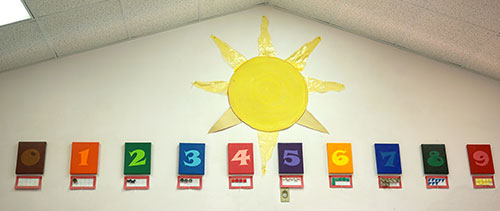
NATURAL SCIENCES
The natural sciences program involves children exploring the world around them with their senses, hands-on work with various materials, plants, and simple experiments. Local field trips around the school and neighborhood take children to outdoor classrooms in which living things are seen, touched and experienced in their natural home. The wonder of nature is cultivated through simple activities, such as helping in a school hoop house garden, exploring the cycles of nature and caring for animals.

SOCIAL EMOTIONAL DEVELOPMENT
Self, Family and Community
Our Social Emotional program is the foundation of the school. It starts in the Unicorn class and continues up through all the grades. In the Unicorn class children spend time exploring feelings: what they look like, feel like and what they are called. We learn about feelings through ASL, interactive stories, books, drawings and body movement. Teaching and discovering our school character traits (Respect, Trust, Courage, Honesty, Compassion and Stewardship) sets the tone for our school and classroom culture. All students learn how they embody them everyday. The students learn how to share and how to express their needs and feelings. The students also learn how to handle uncomfortable situations, using either their words or American Sign Language. “Compassionate Communication” skills are also taught, which help the children learn how to identify and name feelings and learn to say what they need.
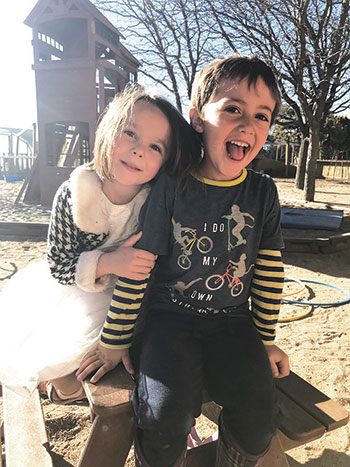
SCHOOL COMMUNITY
The Preschool/Pre-K Program is nestled within a larger school community, with an Elementary and Middle School. Accessing the support of this community is fostered by using other grades as experts, who share what they are learning in their learning expeditions, as well as developing rich relationships through Community Service with older students being “Big Buddies” to the younger students. This relationship and community support deepens as students go through the grades at Arts & Sciences and become Big Buddies themselves as they grow through the different grades, maintaining rich relationships with the students and teachers at Arts & Sciences.
The Preschool and Pre-K classroom is seen as a pivotal foundation where children come to know themselves as active, happy, and successful learners, and as important and special members of a large Arts & Sciences school community.

FACULTY
Santa Fe School for the Arts & Sciences is fortunate to have a stellar team of dynamic and experienced early childhood educators leading our Preschool/Pre-K program.
Aurora Hvidsten
Aurora has taught at Arts & Sciences since 2010. She is the Lead Teacher for the preschool and pre-k students. She received her BA from the University of California Santa Cruz in 2008 and her MS in Early Childhood Education from the Erikson Institute of Chicago in 2015. She is a Girls on the Run assistant coach at A&S for girls in grades 3-5. She is also an active member in the Collaborative Teacher’s Institute and is currently serving on the Library Advisory Board for the city of Santa Fe. Aurora enjoys integrating her love for stories into the classroom and feels passionately about tending to social emotional learning and growth. She is also a parent of a current Kindergarten student When she’s not at school Aurora can be found reading a book, spending time in nature or cuddling her cats. aurora@santafeschool.org
Stephanie Smith
Stephanie has worked with young children for over thirty years, both in California and in northern New Mexico where she has been living since 1997. Stephanie joined the Arts and Sciences staff in 2018 and has served in multiple roles throughout her time here, including Aftercare Teacher and Coordinator, Summer Camp Director, and currently (and most passionately) as a teacher in our Preschool and Pre-Kindergarten Unicorn class. She studied early childhood education at Cabrillo College in Aptos, CA, though she has learned largely through her long experience in education. Co-founder and director of Dragonfly School (toddlers through kindergarten) in Santa Fe for ten years prior to joining Arts & Sciences, Stephanie holds the National Administrators’ Credential for directors of preschool programs. Her expertise includes facilitating compassionate communication; dynamic, hands-on curriculum planning; directing dramatic storytelling in the classroom; and teaching early literacy skills. Stephanie believes that the most important qualities a teacher can bring to the early childhood classroom are a commitment to relationship-building, creativity, and flexibility. When not at school, Stephanie is regularly tending to her large garden and its consequential fruits, rollerskating outdoors, or dancing at live music events. stephanie@santafeschool.org
Annie McLaughlin
Annie joined Arts & Sciences in January of 2021 as a Grasshopper support teacher, substitute, and Centaur assistant. She then taught Creative Movement and Centaur-Badger Drama at SFSAS before moving over to the Unicorn classroom. Annie was born and raised in Northern Virginia as the youngest of 5 children, and she has 16 years of experience in the early childhood field. She previously taught at La Mariposa Montessori in Santa Fe. Annie graduated from Boston College with a B.A. in Human Development and a minor in Irish Studies. She obtained her Masters of Education and AMI Montessori Diploma & Teaching Certificate from Loyola University in Maryland. Annie lives in Santa Fe with her son Colin. She loves to incorporate music and movement into her teaching, and she has led Music Together classes in Santa Fe. When she’s not at school, Annie loves to hike, swim, play basketball and soccer, bake and spend time with her family and friends. annie@santafeschool.org
Kati Novak
Kati is an Assistant Preschool Teacher and Preschool-Kindergarten Lead Aftercare Teacher at Arts & Sciences. At nearly 19, she left Santa Fe for the Pacific Northwest, and for almost 16 years lived in Washington on the Kitsap Peninsula, working first as a line cook and being a young mother before finding her calling as a teacher. She was part of the Boys & Girls Club of Seattle for eight years in Bainbridge Island, where she worked as the Program Director then taught a toddler program at Building Block Preschool. In 2014, She returned to Santa Fe to teach at Dragonfly School until its closing in 2017. Textile arts, gardening and nannying filled the days until landing at Arts and Sciences. Kati’s strengths include allowing children the space and time to accomplish their own goals, her playful yet calm nature and inspiring inquisitiveness through asking pertinent questions. kati@santafeschool.org
Todd Stiewing
In his 21st year at Arts & Sciences, Todd serves as our Principal and Leadership Teacher. For eleven years, Todd taught our 3rd and 4th grade Centaur class and has served in a variety of leadership positions, including Assistant Principal, Elementary Curriculum Coordinator, Staff Liaison to the Board; lead member of the Campus as Curriculum Committee; and Summer Director of Facilities. Todd received a B.S. in Elementary Education and a Master’s in Education from the University of Connecticut. He has over 20 years of teaching experience both in the classroom and working with children, teens and adults in outdoor experiential settings. Before moving to New Mexico in 2004, Todd taught 4th grade and Pre-K through 5th elementary science in Maryland. Todd has many years experience leading wilderness and experiential education courses at schools around the country. Todd’s daughter is an alumna and his son is in 6th grade at Arts & Sciences. todd@santafeschool.org


